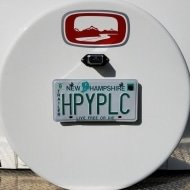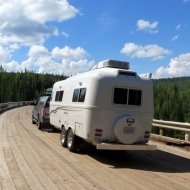Leaderboard
Popular Content
Showing content with the highest reputation on 07/12/2018 in all areas
-
That's what I love about this forum, people are so willing to be informative Steve went out and bought one to do the research and report back how they do.. dedication..2 points
-
The sending unit is stuck to the outside of the tank at the rear. It should be visible through the street side forward hatch under the bed. It will look like a green circuit board glued to the side of the tank with a couple of wires coming off the bottom.2 points
-
It seems like the general consensus here is that compact trucks are borderline capable of towing the Elite II. Most people, including me I guess, will recommend a full size pickup. In my admittedly brief experience here, it seems like people are fine with whatever they're using to tow, but eventually gravitate toward full size pickups sooner or later. Having said that, these threads about tow vehicles remind me of George Carlin's routine about driving, where everyone going slower than you is an idiot and everyone going faster is a maniac. Same's true with tow vehicles - if you want something smaller than what whomever you're asking drives, you're obviously risking your life; and if you want something bigger, you're wasting your money.2 points
-
The curent is reduced as the batteries come up to full charge. I'm discovering that new vehicles have smart charging technologies in their charging systems. Mine does too. After sitting for the night, it comes up to 14 volts to make up for the power drawn to start the engine. Then it goes to "float" like a smart charger and drops back to 13 volts. It will carry additional loads as needed by upping the amps from th ealternator. The same scheme is used in the Oliver battery chargers. Full power to the batteries for a bulk charge. When 14 volts is reached it begine to reduce the amps, to hold that voltage, until a set low point is reached. This is typically about 5 amps. Then it drops into float charge where the maintanance vottage is about 13.1 volts. If additional loads come on, the amperage is ramped up to carry them, but th evoltage ramins at about 13,1. Cars used to always hold at about 14.1 volts while running. Fortunatly cars don't run 24/7 so the batteries would not boil out from continuous overcharging. That voltage was also high enough to prevent sulfating. The three phases currently used by battery chargers and smart car regualtors are: Bulk, absorption and float. this is the best way to make lead acid batteries last. I tried running my AC off an inverter while charging the truck batteries. Remember, this is not the built in inverter in the trailer, but one I carry for other uses in the truck. It's a 3000 watt unit. Inverters seem to be able to double their output for short periods to statr motors. I simply plugged the trailer into the inverter with the shore tie cord. The truck was idling. The trailer batteries were already fully charged. I turned on the AC and it did start, but it was slow to start and I was afraid it might not work on the next cycle, so I shut it off. I wish I had an Easy-Start as that probably would have made the difference. My wiring was sub-par too as the inverter was connected with jumper cables. So, the method is not fully vetted, but, I think, viable. The key is that the starting load is much greater then the running load. So the batteries can get me through the starting load and then be replenished during the running phase, to start again on the next cycle. The AC, as a normal function goes off and on as it does it's job. The generator or the inverter must provide enough amperage to start the compressor, and that is where we are all asking for just about all we can get without going to a very heavy generator.1 point
-
I wouldn't trust the sensor though, since it will read 100% before you're full. Mine will say 100% with ~28 gallons in the tank, and says zero when I still have ~2 gallons left - probably because the sensor is slightly smaller than the tank so it doesn't register the amount above or below it's sensors.1 point
-
1 point
-
The only way any of the 2000 watt (peak output) generators will run the AC is with an easy start because the AC draws more amps to start than the generators can produce. Motors require much more power to get started than they do to continue running. That short term high load lasts for about one second and occurs every time the AC cycles on. The Easy-Start spreads the starting current out over more time, which reduces its peak, and allows the 2000 watt generators to work. But if the microwave is on, the generator won't run both. It's not correct to call the Costco generators "Yamaha generators". They are not. Read the box. It says "powered by Yamaha" It has a Yamaha engine and is made by a company other than Yamaha. Not saying there is anything wrong with them. I have a Yamaha and it is not the same as the Costco Generators. Since the generators are pretty much maxed out running the AC, there isn't anything left to run other 120 volt loads. So, no, they will not run the microwave or the battery charger at full output, while running the AC. They won't even run the AC unless they have an easy start or additional starting condenser. Possibly, the 2200 watt unit would run the AC, but it would not have anything left for any other appliances.1 point
-
We're probably going to Alaska again, but not in our Oliver. Delivering a motorhome. We have a Yamaha 3000 which is way too heavy to drag around the country , but powered a few lights and fans, and two refrigerators, and coffee makers, for two sticks and bricks homes during the hurricane this year. Ours, and our neighbors. I'd get the soft start if you really KNOW you will camp off grid, but will need AC. You can always add it. We chase cooler weather in the summer, and don't use the AC. Pretty much never, except cleaning and loading at our house in Florida. We use a Honda 1000, just to recharge batteries if we run into a streak of crummy weather and don't feel like moving on. If I were you, I'd hedge my bets and get a Honda or Yamaha 2000, that's capable of adding a companion unit. You may find you don't actually " need" AC anymore than we do. But you have the option to add 2000 more watts with a companion unit, if you're wrong... Both brands are well made, super quiet, light enough to handle by one reasonably fit person, and easy on fuel. Our Honda is 10 years old. So is the Yamaha. We use only non ethanol gas, and they never have failed us, and never annoy our neighbors. We run the gas out before storing. Use stabil throughout the season, ... just in case, as our genset gets very infrequent use. Make sure whatever you buy has the "I" in the name. Don't buy a cheapie industrial loud model that can blow up your electronics. My two cents. Sherry1 point
-
Recent Achievements










